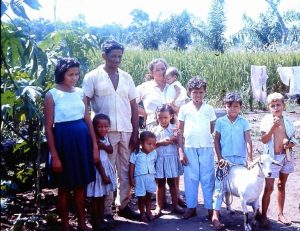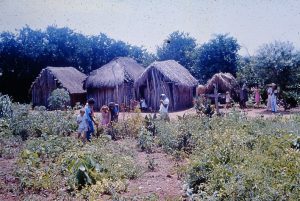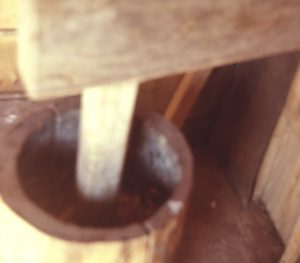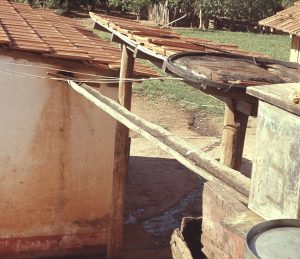30 Caipira Hydraulics
Caipira Hydraulics
The word Caipira refers to poor rural agricultural people in Brazil. My Peace Corps time in Mato Grosso, Brazil was spent working with the Caipira. Most of the Caipira people lived in isolation from the rest of Brazil and knew little of what was going on in the greater country. They contented themselves with their pioneer farming and socialization in their local villages.

Young Caipira family with seven children and one neighbor with a backdrop of a fruit tree, corn, native campo cerrado vegetation and laundry drying on a line.

Older Caipira family whose children were grown and had left home to cultivate their own farms or take-up village life.

Three generations of Caipira managing a food garden in the for ground and orange trees behind.
In their simplistic lives they do some creative things to make it easier for themselves. One family that intrigued me by how they diverted water from a local stream over to their home, channeling water through the kitchen and washrooms.
Water was diverted from upstream into a wooden trough directing it toward the house.
 The trough kept the water flowing at a slower gradient than the rushing stream and allowed it to run at the level of the house.
The trough kept the water flowing at a slower gradient than the rushing stream and allowed it to run at the level of the house.

The trough went through the kitchen where water was captured for drinking, cleaning, and washing dishes and clothes. A block was placed in the trough allowing the water to collect enough for washing.
Once the dishes and clothes were washed the block was pulled out, allowing the soapy water to drain, and the clean water to enter for rinsing.

After that, the water was directed into the hollowed end of a balance beam.

When the weight of the water was enough, the beam tilted, lifting a heavy pestle on the other end. As the water poured out, the monjolo would teeter back, allowing the pestle to fall into a container of grain inside the house. The grain was ground into flour.

An addition to running the water through the flour mill, channeled it along a split hollowed log, leading to the shower house where a cool shower could wash away the toils of the day.
 Another monjolo operating beside a stream with a modern metal pipe pouring the water.
Another monjolo operating beside a stream with a modern metal pipe pouring the water.

